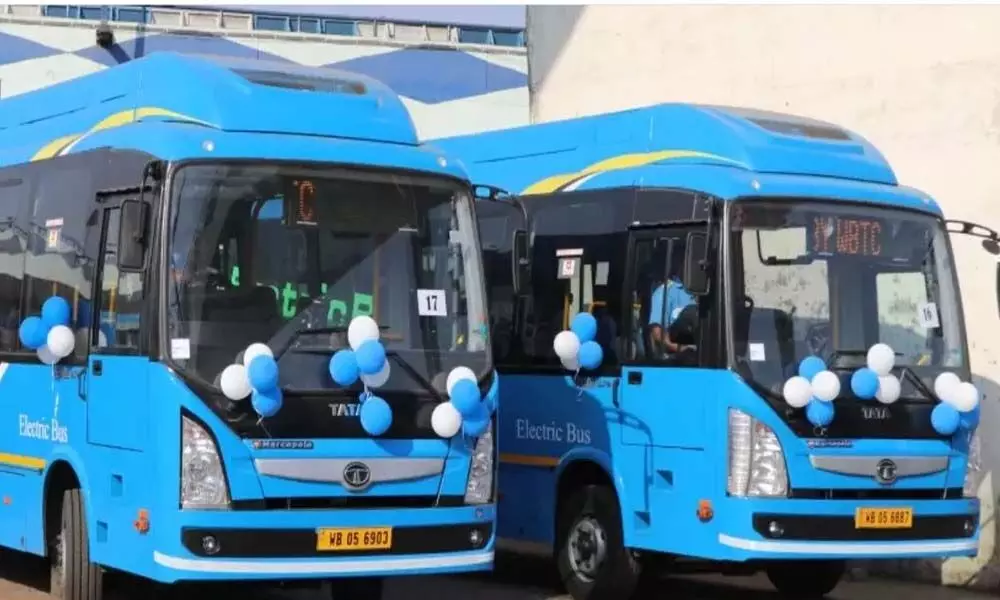FAME-II driving faster adoption of electric public transportation
E-buses expected to account for 8-10% of new bus sales by FY25; GCC, Opex model paving way for e-bus adoption: ICRA
image for illustrative purpose

E-buses are expected to account for 8-10 per cent of new bus sales by FY25 and the segment is likely to be at the forefront of India's electrification drive thereby witnessing healthy traction, according to ratings agency Icra.
Despite the overall stress in the public transportation segment over the past year and a half due to the pandemic, the traction in the e-bus segment is already visible over recent months, Icra said in a statement. The extension of the Faster Adoption and Manufacturing of Hybrid and Electric Vehicles (FAME) scheme by two years to April 2024 would support adoption in the segment over the medium term although the on-ground deployment under the scheme has been somewhat delayed due to pandemic-induced challenges, it added.
Under the scheme, 7m, 9m and 12m electric buses are eligible for a capital subsidy of Rs 35 lakh, Rs 45 lakh and Rs 55 lakh, respectively, subject to meeting technical specifications and localisation requirements. "Bus costs are the single largest cost element in electric bus projects, accounting for 75-80 per cent of project costs. With the capital subsidy of Rs 35-55 lakh per bus under the FAME-II scheme, the capital subsidy element can fund a large part of the project costs, up to even 40 per cent, which augurs well for the viability of these projects," Icra Ratings Vice President and Co-Group Head Srikumar Krishnamurthy said.
Additionally, he said, "Coupled with the significant savings on fuel costs (3 to 5 times cheaper vis-à-vis conventional buses), these subsidies help to bring the total cost of ownership of e-buses on par with the CNG buses, and more importantly 20-30 per cent lower than diesel buses." According to ICRA, while the FAME II scheme and associated subsidies would support the penetration in initial years, expectations are that capital costs would reduce with localisation and evolution in battery technology, which coupled with favourable operating economics, would support sales subsequently. The ratings agency said the gross-cost contract (GCC) model, or opex model of operations, has emerged as the preferred route for e-bus adoption in India, especially as the FAME-II scheme offers capital subsidy only for buses procured under this route.
While this model helps to significantly alleviate the upfront capital burden on cash-strapped state road transport undertaking (SRTUs), also spurring electrification by increasing private participation in the segment, the model is currently evolving, and operators are looking at various measures in order to mitigate the risks prevalent in the model. Icra Ratings Vice President and Sector Head Rohan Kanwar Gupta said it remains to be seen how various risks related to project execution, bus performance and receivables play out over the medium to long term under the GCC model. "While limited charging infrastructure, range anxiety and high capital costs have been the key deterrents in electrification across segments, these are relatively low for the bus segment. Overall, Icra expects that electric buses are likely to account for 8-10 per cent of new bus sales by FY2025," Gupta said. According to him, as the GCC model matures, electric buses are expected to witness increased adoption going forward, aided by the favorable cost economics.
Among the various automotive segments, buses would be among the first ones witnessing faster electrification, especially for intra-city operations. As per Icra, while execution-related risks associated with the GCC model remain relatively low for these projects, operational risks are somewhat higher, given the lack of adequate track record of electric vehicles in the country. "Operators with direct backing from the e-bus original equipment manufacturers (OEMs), and with adequate financial wherewithal and flexibility, would be better placed to establish a strong foothold in this segment," it said.

